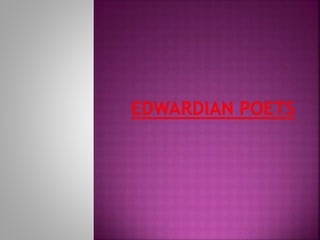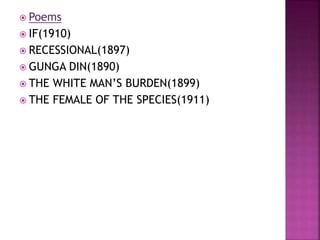The document provides information about English poetry from the Edwardian era (1901-1914). It discusses several prominent poets from this period, including Henry Newbolt, John Masefield, Thomas Hardy, A.E. Housman, Edward Thomas, John Davidson, Rupert Brooke, and W.B. Yeats. These poets wrote in traditional 19th century styles but addressed contemporary social, political, and introspective issues of their time. The era saw prosperity in England but also a rise of criticism of established institutions and a questioning of social structures.


























![ Rudyard Kipling, in full Joseph
Rudyard Kipling, (born December 30,
1865, Bombay [now Mumbai], India—
died January 18, 1936, London,
England), English short-story writer,
poet, and novelist chiefly
remembered for his celebration of
British imperialism, his tales and
poems of British soldiers in India, and
his tales for children. He received
the Nobel Prize for Literature in 1907.
Kipling’s poems and stories were
extraordinarily popular in the late
19th and early 20th century.](https://image.slidesharecdn.com/edwardianpoets3-231231152820-8bffb2c9/85/EDWARDIAN-POETS-3-pptx-27-320.jpg)




